Introduction:
Waterproofing is a process that is meant to keep water from getting into a building. Waterproofing is usually done in steps and layers to create multiple barriers that prevent water from entering the structure. A structure is made waterproof using barriers and coatings to protect the things underneath or inside and the structure itself. So, the performance of a building is also based on how well the materials work together and how they are connected. And this performance is most hurt by the weathering that happens outside, especially rainwater and drains. So, the right way to use a waterproofing system can protect against weather, seepage from the ground, and water moving up and down in a building.
What is Waterproofing?
In building construction, waterproofing is the process of making a building resistant to water or impossible for water to get into. Waterproofing is important because it keeps water from getting into buildings and the inside dry. It helps bring down the humidity inside the building, which keeps furniture and other things from getting damaged as much. Waterproofing is a must in places that get a lot of rain every year and sometimes flood. Basements and walls must be waterproof, especially in places with high water tables. If the water table is high, the water in the dirt will likely put pressure on the basement floor and walls. It can push water through the cracks, which can damage the structure and cause problems like mold, mildew, and decay caused by water.
During the monsoons, all of us have seen water leaking through the ceilings and walls or felt damp after floods. It is because the protection isn’t good. By sealing your house, you can protect the building and the things inside it from damage caused by water and humidity.
Importance of Waterproofing in Building Construction:
Waterproofing is essential to building construction that maintains structural integrity, durability, and overall performance. It involves the application of various materials and techniques to prevent water intrusion into the building components and protect them from water-related damage. Here are some reasons why waterproofing is important in building construction:
(i) Protection against water damage: Waterproofing prevents water from seeping into the building’s foundation, walls, floors, and roofs. Water infiltration can cause extensive damage, including mold growth, corrosion of metal reinforcements, decay of wood, and deterioration of concrete, leading to structural weaknesses and reduced lifespan of the building.
(ii) Prevents structural problems: Water infiltration can weaken the structural elements of a building over time. Moisture penetration into the foundation can lead to cracks, settlement, and shifting, compromising the stability and safety of the structure. Waterproofing helps maintain structural integrity by keeping water away from critical areas.
(iii) Mold and mildew prevention: Moisture and humidity create an ideal mold and mildew growth environment, which can cause health problems and unpleasant odors. Waterproofing measures such as moisture barriers, sealants, and proper drainage systems help prevent the formation of mold and mildew, ensuring a healthier indoor environment.
(iv) Energy efficiency: Water intrusion can affect the insulation properties of building materials. When moisture seeps into walls, floors, or roofs, it reduces their thermal resistance, increasing energy consumption for heating or cooling. By keeping water out, waterproofing contributes to maintaining the building envelope’s energy efficiency.
(v) Long-term cost savings: Investing in waterproofing during the construction phase can save significant costs in the long run. Waterproofing minimizes maintenance and repair expenses by preventing water-related damages, repairs, and potential structural issues. It also helps protect valuable assets and prevents the need for premature replacements.
(vi) Enhanced property value: Buildings with proper waterproofing are more desirable in the real estate market. Potential buyers and tenants are attracted to properties with a reduced risk of water damage and associated problems. Waterproofing can increase the value of a building and make it more marketable.
(vii) Compliance with building codes and regulations: Many buildings require waterproofing measures in areas prone to water intrusions, such as basements, below-grade structures, and wet areas. Compliance with these requirements is essential to ensure the safety and legality of the building.
Types of Waterproofing Used in Building Construction:
1. Cementitious Waterproofing:
Cementitious waterproofing is the easiest way to keep water out of a building. The materials for cementitious sealing are easy to find, and they are also easy to mix and use. It builds a thick, somewhat flexible layer on top of the damaged building against the water. This type of protection is usually rigid or only somewhat flexible. But because it is used in places like bathrooms that aren’t open to the sun, it doesn’t last. So, the agreement and growth process doesn’t happen with cementitious waterproofing.
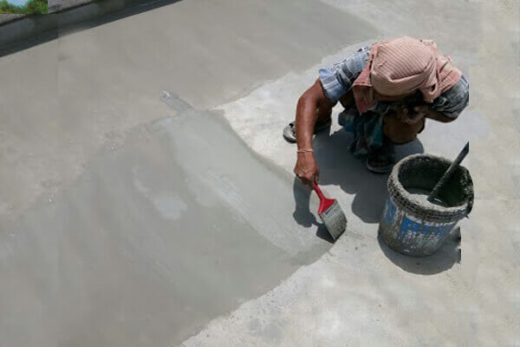
Fig1: Cementitious Waterproofing
Courtesy: uniteqindustries.com
Cementitious frames don’t need a surface to be ready before they are put in place. In any case, it is important to wet the object with water. After the basic work is done, these structures are put on in two layers. Tapecrete is often used to keep water out and is easy to work with. It is used in water treatment plants, sewer treatment plants, bridges, dams, tunnels, railways, river locks and channels, concrete dikes, subway systems, marine cargo ports, docks, parking structures, lots, etc. Before cementitious frames can be put on, the substrates must be cleaned of soil, mud, structure discharge specialists, and other outside materials.
The biggest problem with cementitious waterproofing is its need for suppliers. The concrete doesn’t stretch enough to be worth mentioning. They will stay still in the water but not get any joints or breaks.
2. Liquid Waterproofing Membrane:
The liquid waterproofing membrane is a type of waterproofing material applied as a liquid coating to protect various surfaces from water penetration and damage. It is commonly used in construction and building maintenance to provide a seamless, durable, and watertight barrier on roofs, walls, basements, decks, and other areas susceptible to water intrusion. When applied and cured, liquid waterproofing membranes typically comprise polymers, resins, and other additives that create a flexible and impermeable layer. They are available in different formulations, such as acrylic, polyurethane, or bitumen-based products, each with advantages and suitable applications.
The application process of liquid waterproofing membranes involves cleaning and preparing the surface, ensuring it is free of dirt, debris, and loose materials. The liquid membrane is then applied using a brush, roller, or spray equipment, depending on the product and surface being treated. Once applied, the liquid membrane cures and forms a continuous, seamless, and flexible membrane that adheres tightly to the surface, providing excellent resistance against water infiltration, UV rays, and mechanical stresses. It can accommodate structural movements without cracking and protects the underlying substrate from moisture damage.
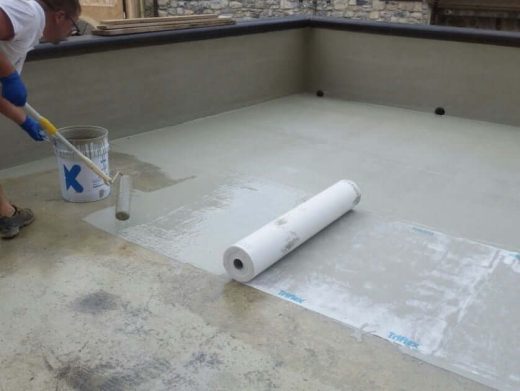
Fig2: Liquid Waterproofing Membrane
Courtesy: archiproducts.com
3. Bituminous Coating Waterproofing:
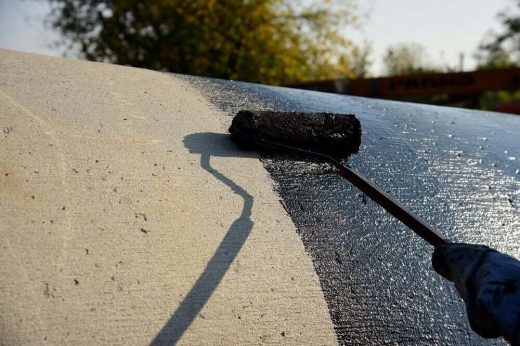
Fig3: Bituminous Coating Waterproofing
Courtesy: corrosionpedia.com
Bituminous coating waterproofing is a protective layer applied to various surfaces to prevent water infiltration and provide waterproofing. It utilizes a bitumen-based material, a viscous, black, and sticky substance derived from crude oil. Bitumen has excellent water resistance properties, making it an effective choice for waterproofing applications. The bituminous coating waterproofing involves applying a layer of bitumen to the surface that needs protection. The surface can be concrete, metal, masonry, or even wood. Before the coating is applied, the surface is cleaned and prepared to ensure proper adhesion.
The surface is cleaned thoroughly to remove dirt, dust, grease, or loose particles. It may also involve repairing cracks, gaps, or damaged areas to ensure a smooth and even coating application. A primer is often applied to the prepared surface before the bituminous coating. The primer helps improve adhesion and promotes better surface and coating bonding. The bituminous coating is applied using various methods such as brushing, spraying, or troweling. It is important to apply an adequate coating thickness to ensure effective waterproofing. Multiple coats may be applied, allowing each coat to dry before applying the next.
In some cases, a reinforcement layer is added to enhance the strength and durability of the waterproofing system. It can involve using a reinforcing fabric or membrane embedded within the bitumen coating. Once the bituminous coating is applied, it needs time to cure and dry. It allows the bitumen to harden and form a solid, waterproof barrier.
4. Bituminous Membrane Waterproofing:
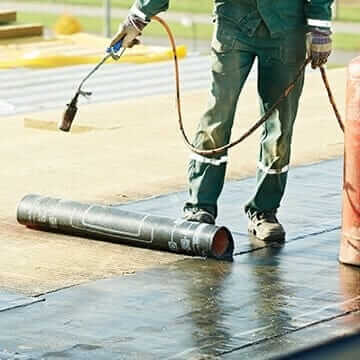
Fig4: Bituminous Membrane Waterproofing
Courtesy: baumerk.com
Bituminous membranes are a popular way to protect low-slope roofs because they have been shown to work well. The bituminous sealing membrane has a torch and a membrane that sticks to it. Self-adhesive materials are made of asphalt, polymers, and filler. Resins and oils can also be added to improve how well they stick. The self-adhesive kind has a short shelf life because the membrane loses its ability to stick together over time.
There are both open and covered types of torch-on membranes. The visible layer usually has small pieces of mineral aggregate to protect it from the wear and tear of weathering. The worker must put down one protective screed for the other kind of membrane to keep the membrane from getting holes.
5. Polyurethane Liquid Membrane Waterproofing: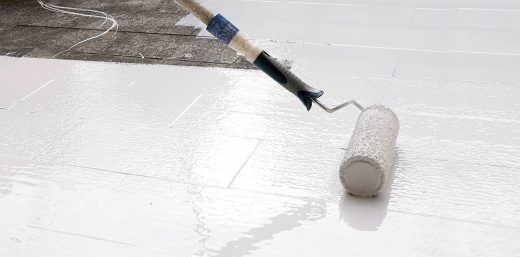
Fig5: Polyurethane Liquid Membrane Waterproofing
Courtesy: wet2drysolution.com
Polyurethane liquid membrane waterproofing is best for flat roof areas subject to UV rays, fuel spillage, and weathering. This type of waterproofing is preferred because it is easier to use and needs less skill and supervision. Also, the work goes quickly, which could be used after the building is done. This protection gives a nice finish and is very durable. But polyurethane is sensitive to moisture, so extra care must be taken, or the membrane may peel off before the design time.
Advantages of Waterproofing in Building Construction:
- Waterproofing creates a barrier preventing water penetration and protecting structures and materials from moisture damage.
- Waterproofing helps extend the lifespan of buildings, infrastructure, and various products by preventing water damage.
- By preventing water intrusion, it minimizes the risk of concrete or masonry erosion, reinforcing steel corrosion, and the subsequent degradation of the structural components.
- Waterproofing systems can enhance energy efficiency in buildings by minimizing heat loss and reducing the need for excessive heating or cooling.
- Waterproofing helps create a healthier and safer environment by preventing the growth of mold, mildew, and bacteria.
- While an initial investment is involved in waterproofing, it can lead to long-term cost savings.
- Waterproofing is often considered a valuable investment, as it improves a property’s overall quality and durability.
- Waterproofing techniques and materials are available for various applications, including roofs, basements, foundations, swimming pools, tunnels, and fabrics. This versatility allows for effective moisture protection in various environments and industries.
Conclusion:
Waterproofing is an important process that helps protect various structures, materials, and surfaces from water damage. Applying waterproofing techniques can significantly enhance their longevity and prevent costly repairs or replacements, whether it is a building, a basement, a roof, or even electronic devices. Waterproofing methods vary depending on the specific application and the materials involved. Common waterproofing techniques include using sealants, membranes, coatings, and specialized waterproofing systems. These methods create a barrier that prevents water from penetrating or seeping into the protected area.
References:
1. What are the Waterproofing Materials? All Types and Features | Baumerk. (n.d.). What Are the Waterproofing Materials? All Types and Features | Baumerk. https://www.baumerk.com/en/blog/what-are-the-waterproofing-materials
2. N. (2021, February 18). 5 Types of Waterproofing in Construction | MCT Group of Companies. MCT Group of Companies. https://www.mctuae.com/blog/5-types-of-waterproofing-in-construction/
3. Waterproofing in building construction – Constro Facilitator. (2020, March 4). Constro Facilitator. https://constrofacilitator.com/waterproofing-in-building-construction/
4. H. (2020, May 17). Types of Waterproofing Used in Building Construction – Happho. Happho. https://happho.com/types-of-waterproofing-used-in-residential-constructions/
5. A. (2019, March 26). Different Types of Waterproofing Methods Popularly Used In Construction – WICR, Inc. WICR, Inc. https://www.wicrwaterproofing.com/different-types-waterproofing/
6. Shibam, T. (2021, September 28). Types of Waterproofing | Shibam Ventures. Shibam Ventures | Roofing Shingles, Waterproofing, Construction Chemicals. https://www.shibamventures.com/types-of-waterproofing/
If you have a query, you can ask a question here.


